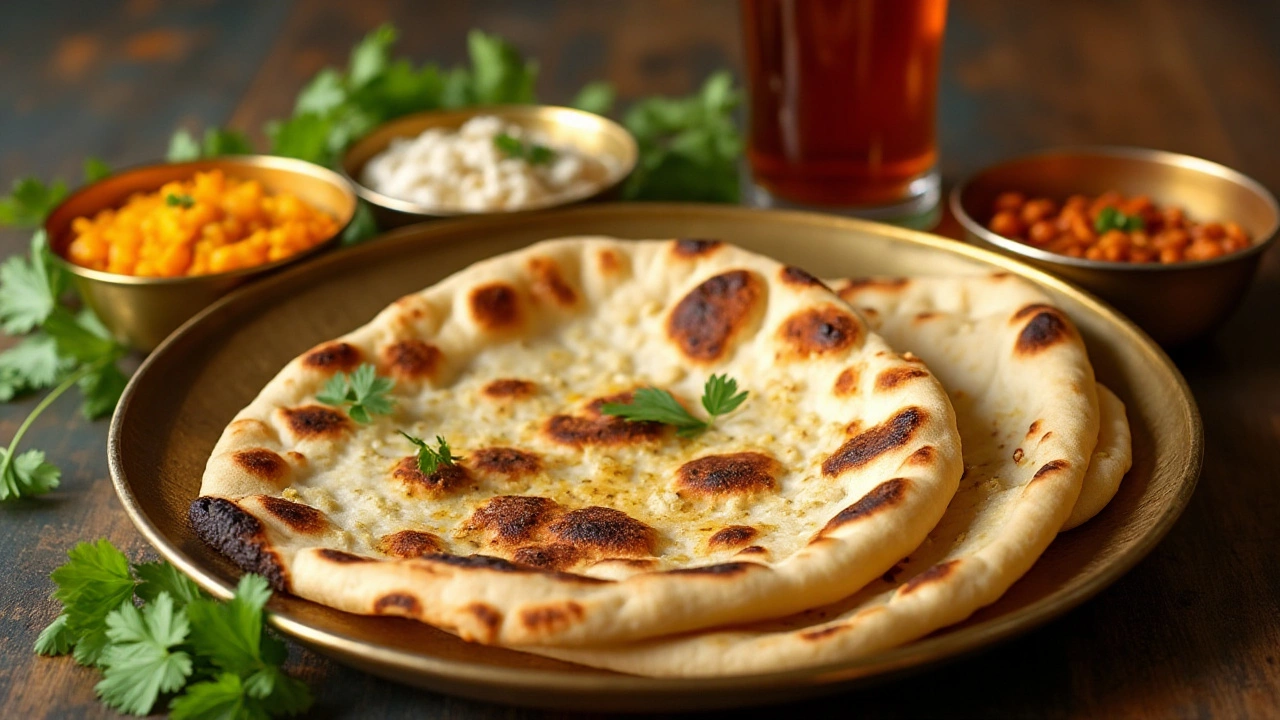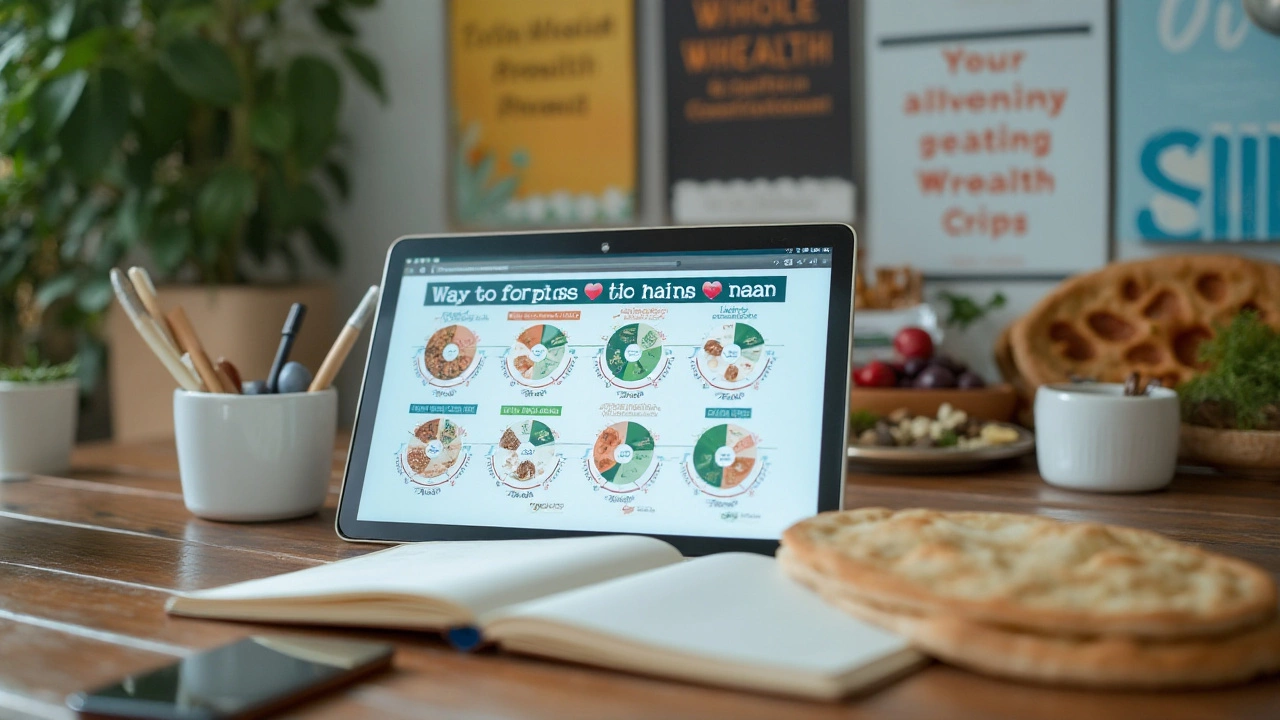Naan, with its delightful aroma and flavor, often finds itself gracing the tables of Indian households and restaurants alike. It’s hard to resist dipping a warm piece into your favorite curry, but when it comes to labeling naan as junk food, opinions can vary. It's important to take a closer look at exactly what goes into making naan and how it fits into our diet.
Understanding whether naan is a healthy choice starts with examining its ingredients and preparation methods. Traditionally, naan is made from white flour, yeast, and yogurt, which can contribute to its unique taste and mouthfeel. However, modifications in recipes can alter its nutritional profile significantly. So come along as we unravel the mysteries behind this beloved bread and discover how you can enjoy naan as part of a nutritious meal.
- What is Naan?
- Nutritional Breakdown
- Is Naan Junk Food?
- Healthier Versions of Naan
- Tips for Including Naan in a Balanced Diet
What is Naan?
Naan is a type of leavened flatbread that holds a special place in Indian cuisine. Its origin is believed to trace back to the Indian subcontinent, though the word 'naan' itself is Persian in derivation, meaning 'bread.' Traditionally cooked in a tandoor, a clay oven that imparts a distinct smoky flavor, naan has transcended cultural boundaries and is enjoyed by food lovers around the globe.
The preparation of naan typically involves simple ingredients: white flour, yeast, milk or water, and a bit of salt. Some variations include yogurt which helps to make the dough softer. When kneaded into a smooth, pliable dough, it is set aside to rise, taking on an airy texture that makes it unique among breads. Once ready for cooking, the dough is divided into smaller portions and rolled out before being slapped onto the walls of the tandoor, where it cooks quickly under intense heat.
This cooking method gives naan its characteristic texture—soft on the inside with a slight char on the outside. Although traditionally authentic naan is cooked in a tandoor, alternatives are available for home cooks without such equipment. Griddles or ovens are suitable substitutes for recreating a similar outcome. It's the slight char and puffiness that makes naan so versatile, serving as the perfect tool for sopping up rich gravies or flavorful sauces.
Naan comes in various shapes and sizes, and its recipes offer a myriad of variations. From the classic plain naan to butter, garlic, and even stuffed versions, this bread adapts well to different tastes and preferences. One might add ingredients like nigella seeds, cilantro, or minced garlic into the dough for additional flavor.
"Naan is an essential accompaniment to Indian meals, but its soft and savory quality has appealed to a global palate," says renowned chef Madhur Jaffrey. "It's an example of how simple ingredients come together to create something delightfully complex."
In some culinary practices, adding fenugreek or aniseed is not uncommon, further enhancing the taste profile of naan. Whether you choose to make your own at home or enjoy it in an Indian restaurant, naan's ubiquitous appeal remains undeniable. While the traditional method of preparation is steeped in age-old practices, innovations and contemporary variations continue to keep naan in culinary conversations across diverse cuisines.
Nutritional Breakdown
At the heart of any discussion about naan lies its nutritional composition. As a beloved staple in Indian cuisine, understanding the dietary impact of consuming naan is critical, much like how we approach any food with keen curiosity about its benefits and drawbacks. Traditionally, naan is crafted using white flour, water, yeast, and yogurt, giving it a soft and airy texture that pairs perfectly with a variety of dishes. This delightful bread often contains about 260 calories per piece, primarily due to the flour and fat content, making it a delectable yet calorically dense choice.
When examining the macronutrients, a single piece of naan typically provides around 8 grams of protein, making it a surprising source of this essential nutrient, especially when served with protein-rich accompaniments such as lentils or meat. Meanwhile, carbohydrates make up the majority of its composition, with about 46 grams per piece, supplying a quick source of energy. However, it's crucial to note the 10 grams of fat that often accompany naan, primarily owing to the use of butter or ghee in many recipes, which can contribute to its high calorie count.
For those mindful of their dietary fiber intake, naan might not be the most generous option considering it generally contains less than 2 grams of fiber per serving. This is where choosing whole grain variants or incorporating fiber-rich sides can prove beneficial. In terms of vitamins and minerals, naan provides modest amounts of calcium and iron, thanks to the yoghurt and yeast, yet it's not the primary source for these nutrients in a balanced diet. A significant aspect to consider is its sodium content, which can vary widely depending on preparation, often reaching up to 420 milligrams per serving, highlighting the need for cautious consumption, particularly for those managing blood pressure.
Dr. Anjali Mukherjee, renowned nutritionist, once remarked, 'Understanding the nutritional landscape of your food choices can empower you to make informed decisions that align with your health goals.'
Incorporating naan into one's diet requires a mindful approach, considering how it fits alongside other daily nutrients. There are creative ways to tweak traditional recipes to make healthier versions without sacrificing flavor. For instance, opting for whole wheat flour instead of white can enhance its fiber content, while reducing the sodium by minimizing added salt can align it better with health-conscious choices. Exploring such adjustments can transform naan from a potential indulgence into a staple that's in harmony with nutritious living.
Overall, when evaluating whether naan qualifies as junk food, it’s important to weigh its flavorful appeal against its nutritional make-up. While it's not inherently unhealthy, like any comforting dish, moderation and balance play essential roles. By being vigilant about portion sizes and opting for wholesome recipes, naan can comfortably nestle into even the most nutrition-focused meal plans, thus preserving not just the rich culinary heritage of Indian cuisine but also one’s health aspirations.

Is Naan Junk Food?
The question of whether naan should be classified as junk food is quite intriguing. On one hand, it's associated with indulgence, given its rich flavor and fluffy texture. Traditionally, naan is made with all-purpose flour, baked in tandoor ovens, sometimes brushed with butter or ghee afterwards. This combination can make it calorie-dense, particularly when compared to simpler forms of bread. A typical naan may contain around 300 calories depending on its size and additional ingredients like cheese or garlic.
However, labeling naan as 'junk food' may be doing it a disservice. The main definition of junk food revolves around foods that offer little to no nutritional value while being high in calories, sugars, or unhealthy fats. While naan can be calorie-heavy, it is not devoid of nutrients. Ingredients like yogurt or milk in the dough add some nutritional value in the form of calcium and protein. Moreover, when made with whole wheat flour, naan adds fiber to the diet, something not commonly found in many junk foods.
Whether naan fits into the junk food category can also depend on how often it's consumed and in what context. Eaten occasionally, naan can complement a hearty, nutrient-rich meal. Pairing naan with dishes that are rich in vegetables, lean proteins, or legumes can balance its contribution of extra calories. As India's gastro-industrial landscape evolves, healthier versions of naan have emerged, which incorporate alternative flours like whole wheat or millet, reducing the number of empty calories.
To gain a perspective over this debate, consider insights from Chef Madhur Jaffrey, a notable figure in Indian cuisine, who once remarked, "Naan should not be vilified merely for its indulgent qualities. When consumed mindfully, with an understanding of its role in our meals, it can be part of a healthy lifestyle." This echoes the idea that moderation and context matter when assessing any food's impact on health.
Understanding the reputation of naan requires one to consider the broader context of dietary habits. Examining its preparation and the way it's consumed can lead to the conclusion that naan, enjoyed as part of a balanced diet, doesn't deserve the stigma related to typical junk foods. It's helpful to explore various nutritious alternatives and recipes, enabling people to experience the joy of naan without the guilt often associated with high-calorie comfort foods.
Healthier Versions of Naan
When it comes to enjoying the beloved naan without feeling guilty about calories, there are plenty of creative ways to make it healthier. The traditional recipe, which uses refined white flour and often oil or butter, can indeed be calorie-dense. However, by swapping these ingredients with healthier alternatives, you can create a nutritious version that doesn't compromise on taste. One popular substitute is using whole wheat flour instead of refined flour. Whole grains retain most of their dietary fiber, which aids in digestion and keeps you feeling fuller for longer. This small change can make a significant difference in the bread's overall nutrition.
For those who want a dairy-free option, consider using plant-based yogurt or skipping the yogurt altogether, adding a splash of almond or oat milk to achieve the right texture. This substitution can also be great for those with lactose intolerance or simply looking to cut down on animal products. Another way to increase the nutritional value and texture of naan is by adding seeds such as chia or flax, which are rich in omega-3 fatty acids and antioxidants. These tiny additions can enrich the bread with essential nutrients without altering its taste significantly.
Incorporating herbs and spices directly into the dough is a tasty way to boost flavor while adding health benefits. Fresh herbs like cilantro or mint, along with spices such as cumin or turmeric, can provide not just zing but also anti-inflammatory properties. Engaging your creative culinary instincts can lead to delightful discoveries. Consider a sourdough element by letting a portion of the dough ferment naturally for extra probiotics that help improve gut health.
According to the National Institute of Health, probiotics can aid digestion and strengthen the immune system, making this a delicious way to support overall health.Don't forget the cooking method either. Instead of frying, opt for baking in a hot oven or using a cast-iron skillet to achieve similar results with less oil.
If calorie count is on your mind, aim for serving sizes that align with your dietary goals. Consider making mini versions of naan – these smaller portions can be both practical and delightful, especially when used as a base for various toppings. Have you tried naan pizzas with vegetable toppings and a sprinkle of cheese? It's a delicious twist that can turn naan into a multi-purpose dish. Below is a quick glance at the comparison:
| Nutrient (per 100g) | Traditional Naan | Whole Wheat Naan |
|---|---|---|
| Calories | 310 | 250 |
| Fiber (g) | 2 | 5 |
| Protein (g) | 8 | 9 |
This table shows the difference in calorie and fiber content between traditional and whole wheat naan. Notice the significant increase in fiber, contributing to a more balanced diet. Healthy cooking doesn't have to be dull. By experimenting with different ingredients and cooking techniques, you can enjoy naan in all its delicious forms while keeping your well-being in check. So get inventive in the kitchen, and let a healthier naan lead to satisfying meals.

Tips for Including Naan in a Balanced Diet
Incorporating naan into your daily meals can be both enjoyable and health-conscious if you do it wisely. The first step is to mindfully plan your portions. Naan is often rich in carbohydrates, and while it's a delightful addition to your meal, moderation is the key. By watching your portion sizes, you ensure that your carbohydrate intake remains within healthy limits. Consider pairing naan with a generous serving of vegetables or a lean protein source. This practice not only adds nutritional value but also helps balance the meal by offering a combination of essential nutrients.
Another strategy is preparing naan with whole-grain or multigrain flour, which adds fiber and vital nutrients. This switch won't compromise on taste and will keep you feeling full longer. If cooking is your thing, try making it at home. It's an excellent opportunity to experiment with healthier ingredients like incorporating spinach puree or grated carrots into the dough. Not only do these additions boost vitamin intake, but they also reinvigorate the naan with a vibrant color and unique flavor profile.
For those days when you fancy a slight indulgence, consider toppings or fillings that add nutritional boosts. Stuff your naan with flaxseeds or chia seeds, which provide essential omega-3 fatty acids. Alternatively, spread a thin layer of low-fat cheese alongside crushed garlic before baking for an extra zing while limiting unnecessary fats.
"Eating a slice of buttered naan is a delightful experience but opting for healthier toppings can make it a regular part of your life," suggests culinary expert Anjali Pathak in her cookbook.
If you are mindful of your dietary requirements and aim to control calorie intake, consider baking instead of frying naan. Baking uses less oil, thus cutting down on unnecessary calories. If eating out, try to avoid restaurants drenching naan in ghee or butter. If you find this to be difficult, balance it by having a lighter main dish. For example, opt for tomato-based or grilled dishes rather than cream-heavy curries to complement the naan without going overboard.
Incorporating nutrition from other food groups is another tip to keep your meal balanced. Don’t limit yourself to Indian cuisine when serving naan. It serves as a versatile bread that mixes well with Middle Eastern and Mediterranean flavors, like hummus or tzatziki. Its mild taste makes it an excellent base for various healthy dips full of vitamins, offering a satisfying alternate twist.
By blending creativity with nutritional value, you make naan a cherished part of a nutritious diet rather than viewing it as a rare indulgence. Afinal point to remember is to explore its potential across meals. Be it breakfast, lunch, or dinner, by using imaginative ways to enjoy it, naan transforms from a periodic treat to an inseparable yet sensible diet staple without the guilt associated with junk food.
